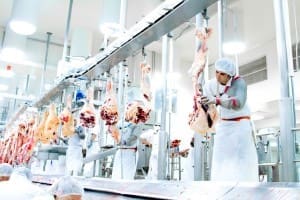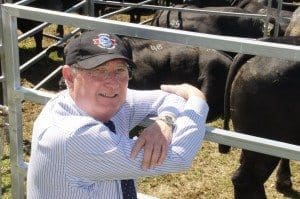EXPORT and domestic beef processor Teys Australia is embarking on an historic move designed to reward producers for the meat yield their cattle produce, as well as their quality.
The company shared details of its vision to move to Value-Based-Payment system with suppliers attending a field day at its Condamine feedlot on Queensland’s Darling Downs on Friday.
If delivered, it would represent the first-ever time that yield has been considered in payment structures in the history of the Australian beef industry – at least on any significant scale.
 Driven squarely by some of the exciting technology breakthroughs occurring in the field of carcase analysis (click here to see an earlier Beef Central article on this topic), Teys says it is “100 percent confident” that current technologies provide the accuracy and repeatability to allow it to confidently build yield performance into commercial livestock payment systems.
Driven squarely by some of the exciting technology breakthroughs occurring in the field of carcase analysis (click here to see an earlier Beef Central article on this topic), Teys says it is “100 percent confident” that current technologies provide the accuracy and repeatability to allow it to confidently build yield performance into commercial livestock payment systems.
 The big difference is that latest-generation analytic technologies like Dual-Energy X-ray do not rely on yield indicators like eye muscle area and fatness to establish a yield ‘prediction’, but instead provide actual composition of each scanned carcase, accurately broken down into red meat, fat and bone.
The big difference is that latest-generation analytic technologies like Dual-Energy X-ray do not rely on yield indicators like eye muscle area and fatness to establish a yield ‘prediction’, but instead provide actual composition of each scanned carcase, accurately broken down into red meat, fat and bone.
MLA’s Dr Alex Ball says it is not uncommon to see an $80 variance in value between two carcases of identical weight and fatness, based solely on the amount of saleable meat each body contains.
Teys’ announcement on Friday is about ultimately rewarding those better yield performers, and over time, shifting a greater population of beef carcases towards the desirable end of the scale.
To put Friday’s announcement into some perspective, it perhaps ranks alongside Teys’ decision to commercially adopt Meat Standards Australia grading and payment incentives in early 2008, as a livestock pricing milestone for producers.
Under Teys’ plan, it is confident it will be rewarding cattle producers based on meat yield performance (along with existing quality parameters) within the next 18 months to two years. Not everyone will benefit in the initial stages, as the process is progressively rolled-out.
The program will likely start with premium MSA-type cattle, both grass and grainfed, but ultimately could involve the entire spectrum of Teys’ 1.5 million Australian slaughter cattle each year.
“We’ve been doing a lot of work behind the scenes about adoption of VBM for the past 12 months,” Teys general manager corporate services Tom Maguire told Friday’s gathering.
A range of different technologies are under trial, to ascertain which is going to work the best for the company’s needs.
Some producers will start receiving yield feedback
Mr Maguire said the true value of each carcase was its saleable meat yield, multiplied by its quality value.
“At the moment, there is a wide range of criteria within the AusMeat language that ‘tries’ to tell us what the yield value is. But what we want to do with the new technologies is replace current predictive measurements like eye-muscle area, carcase weight, sex, butt shape, and P8/rib fat with a true yield assessment,” he said.
“It means that the signal we can send through our price grids in future is much more an indication of the way our customers and consumers value the product,” he said.
Given the ability through technology now to determine fat, meat and bone in each carcase, the tricky bit was in working out a ‘fair split’ in terms of producer payment on yield.
“We’re on that journey, and we’re actually in a position now where we want to engage with a small, sample group of producers in different areas of Australia before Christmas, to start to provide details on yield performance as part of our carcase feedback. They will get indicative yield figures on their cattle, together with a theoretical indication of how that would impact on price, under VBM.”
As more producers begin to receive yield feedback, it will provide better information to allow application of on-farm management/genetics to improve returns in future years.
“We’ll still continue to pay based on current grid payment structures, until everybody involved has confidence in the performance of the new yield calculation technologies,” Mr Maguire said.
“But providing feedback on yield means those suppliers will get the opportunity to see what the world might look like, a little further ahead.”
“We have to start the conversation,” he said.
“From our perspective, the critical success factor is the cultural change required with our suppliers – it’s even more important than the technology developments which are currently taking place.”
“But Teys won’t be making any changes to current payment systems until such time our suppliers are completely comfortable with the new systems. We will do this by delivering lots of feedback as we trial new systems,” Mr Maguire said.
Value in removing subjectivity from carcase assessment
Adoption of the new carcase analysis technologies also promised to deliver other advantages in addition to yield assessment and VBM, Mr Maguire said.
“The AusMeat language and the way assessments are made has served the industry well for 30 years – but from our perspective, it’s not good enough, any more. If we are going to achieve the sort of vision we have for collaborative supply chains with producers, we have to get a lot smarter about how we grade cattle, and give our suppliers absolute confidence that we’re grading cattle in accordance with our customers’ requirements, and what consumers are telling us.”
Grading accuracy and repeatability, based on current subjective assessments, was a common theme raised by stakeholders giving evidence at the recent Senate Inquiry into red meat processing.
“I think where we are heading with this technology, the machines will take over from company graders,” Teys general manage livestock Geoff Teys said.
“We’re working with the technologies to take out the human factor from the equation.”
While not intended as a criticism of current AusMeat assessment performance, new hyper spectral cameras and other technologies taking images of meat and fat colour and other criteria meant that if a producer wanted to challenge the accuracy of a carcase grading at any time, the processor and the producer could sit down with the image and discuss it,” Mr Teys said.
Dairy industry provides guidance
Teys was now firmly committed to moving in the direction of VBM, Mr Maguire told the Condamine gathering.
“We’re at the stage where we’ve done all the research – we have records on two million cattle sitting in a database, but we now want to get some producers together and start trialling it.”
He used the dairy industry as an analogy over how clear price signals sent to producers could ‘bend the curve’ in terms of supply chain performance. The average Australian dairy cow in 1980 produced 2848 litres of milk each year. The figure today was 5891 litres.
“Dairy farmers would not be around today of they had continued to do what they did in 1980,” he said. “The good news is, the genetic and management tools used in dairy are the same tools available to the beef industry – we just have to send the right signals, to lead the industry in the right direction.”
“What the dairy industry has shown is that producers are really clever at doing things to lift performance, if they are given the right signals.”
Teys says the next steps are to continue to work with the research community on the new analytic technologies, and to come up with a new definition of yield that all of industry can agree to.
“We’re at the position now where we have to stop talking, and get started,” Mr Maguire said.
“Thanks to MLA and the team led by Alex Ball, we now have equations where we can start to estimate yields, in order to get the conversation underway. And it’s those collaborative producers we initially want to have those conversations with.”
Producer reaction
Reaction from producers attending the Condamine feedlot field day on Friday was enthusiastic.
Several told beef Central it made a lot of sense, and provided a shared future for the industry. The over-riding message was: “Stick at it, Teys.”
Dulacca producer Lee MacNicol said he was more than happy to participate as a guinea pig in the Value-Based Marketing assessment.
The implications for a yield consideration in producer payment structures are broad, and will take some time to absorb, however.
For one thing, it will inevitably mean a need for additional selection pressure on seedstock cattle, for meat yield, as well as quality performance.
“It will take the seedstock industry to another dimension,” Geoff Teys said.
“The rewards to people to invest in seedstock that is going to improve both the volume and quality of meat will be enormous,” he said.
“But it’s important to note that the need for meat quality will not diminish, after yield becomes part of the equation. You can go out now and buy a double-muscled animal and extract a huge meat yield out of it – but it has no eating quality. We’ll be looking for an animal that has eating quality, under the MSA attributes, while also producing superior yield. Fortunately there are cattle out there in all breeds that can do both.”
Beef Central asked what the project meant for the 50pc of cattle on the bell curve that will be below the average yield figure, which conceivably will be discounted on price under any future VBM system.
“There’s a lot to sort out over the next two-year period of implementation, and we think the only way to achieve this is to work with people collaboratively,” Tom Maguire said.
“Providing alternative feedback to producers is the first step, answering such questions along the way. We can’t make it up ourselves and then go and hand-it-out. But the objective, over time, is obviously to get relatively more of those cattle on the right side of the yield performance ledger, creating more value, and increasing the value for everybody.”


Excellent initiative . Finally we are going to have a system that rewards us for the true value of our cattle and sends the right signals and feedback to the industry to give producers the incentive to improve lean beef yield whilst still maintaining quality.Keep up the good work and I hope the technology is also adopted in WA.
is my dream to work in australia teys , I live in brazil and for this reason. I have this great barrier not able to work for the company
Good initiative. Happy to discuss options for collaboration from CA
Agree with Tony’s comment.
Happy to be a guinea pig in WA if Harvey Beef would work with Teys and take up the challenge! Then we producers would really value feedback from processors.
This is a development of great industry-wide significance. Value-based marketing has been a vision for years – Woolworths went close to implementing it a decade ago, but could not get the yield predictive performance it needed from the old VIAscan technology. Good on Teys for taking the lead, and having a go. How long will it be before JBS makes a similar move – they are examining similar carcase assessment systems in lamb, and shortly beef.